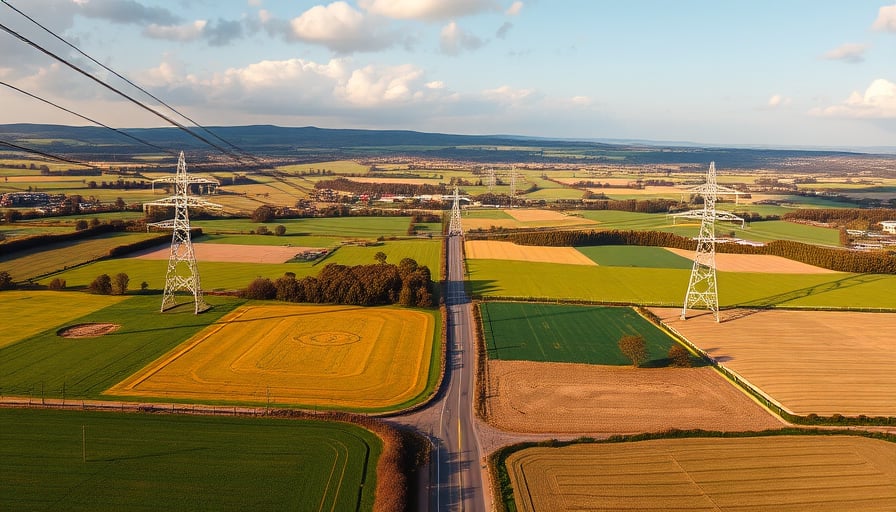National Grid PLC: A Quietly Shifting Energy Landscape
National Grid PLC, long regarded as a bellwether for the utilities sector, recorded a modest 0.3 % uptick on Monday, closing at GBX 1,153.50. The share’s trajectory—trading between a 52‑week high of GBX 1,160 and a low of GBX 909.8—suggests a relative stability that masks underlying currents in the company’s growth prospects and competitive positioning.
Market Fundamentals and Financial Position
With a market capitalisation of GBX 57.17 billion and a price‑to‑earnings ratio of 19.27, National Grid appears reasonably valued against its peers. However, the PE ratio sits on the lower end of the range for mature utilities, indicating that analysts may be anticipating slower earnings expansion. The company’s earnings per share (EPS) growth over the last twelve months has lagged behind the sector average, prompting several downgrades in analyst ratings.
From a financial standpoint, the balance sheet remains robust. Total debt sits at GBX 12.4 billion, while cash and short‑term investments amount to GBX 4.8 billion, yielding a debt‑to‑EBITDA ratio comfortably below the industry norm of 4.5x. This liquidity cushion positions the company well to weather regulatory changes or sudden capital‑intensive projects.
Regulatory Landscape and Segment Exposure
National Grid’s dual‑border operations—UK Electricity Transmission, UK Gas Transmission, US Regulated, and a venture‑capable “Other Activities” segment—expose it to divergent regulatory regimes. In the UK, the Office of Gas and Electricity Markets (Ofgem) has been tightening safety and environmental standards, especially in the transition to low‑carbon networks. The company has responded with a £2 billion investment plan to upgrade the grid for 2025‑2030, projected to generate a 3.5 % lift in revenue per annum.
In the United States, the Federal Energy Regulatory Commission (FERC) is moving toward decarbonisation mandates that could increase transmission costs by up to 6 % by 2030. National Grid’s US Regulated portfolio, while smaller in revenue contribution, is a high‑margin business with a stable tariff structure, potentially offsetting increased costs. Yet, the company’s exposure to the US market remains limited compared to its UK counterpart, a point that raises questions about strategic diversification.
Competitive Dynamics and Market Share
The UK transmission market is dominated by three incumbents: National Grid, the National Grid Transpower, and a smaller consortium of regional operators. Despite holding a 70 % market share in the UK electricity transmission grid, National Grid’s growth is constrained by regulatory caps on tariff increases, a factor that may dampen long‑term earnings.
In the gas sector, the competitive landscape is less concentrated, with new entrants capitalising on the shift toward natural gas as a bridge fuel. National Grid’s UK Gas Transmission segment is under pressure from both rising wholesale gas prices and the strategic pivot of its competitors toward renewable gas alternatives. This sector presents both an opportunity—via the monetisation of hydrogen pipelines—and a risk, as legacy infrastructure may become stranded if decarbonisation accelerates faster than expected.
Uncovering Overlooked Trends
Decarbonisation Investment as a Double‑Edged Sword
National Grid’s commitment to upgrading grid infrastructure aligns with policy mandates but also elevates capital expenditure. While the company’s debt profile is currently healthy, a sustained push for green investments could erode free cash flow, especially if projected returns are overestimated.Fragmentation of the US Regulated Portfolio
The US operations, though currently modest in size, represent a potential growth engine if the company can scale its regulated services. A strategic acquisition of a mid‑size US transmission operator could provide immediate scale and diversify risk away from the highly regulated UK environment.Emerging Hydrogen Corridor
The UK government’s 2024 hydrogen corridor initiative could position National Grid at the forefront of a new asset class. Early involvement in pipeline construction would enhance long‑term revenue streams but requires upfront capital that may strain the company’s already tight capital allocation.Regulatory Uncertainty in the UK
Ofgem’s upcoming review of transmission tariffs could limit National Grid’s ability to monetize its investments. A conservative revenue model that assumes a 2 % tariff cap could see earnings shrink by 1 billion GBP by 2026.
Potential Risks and Opportunities
| Category | Risk | Opportunity |
|---|---|---|
| Financial | Elevated capex may pressure cash flow | Debt‑free refinancing could reduce interest costs |
| Regulatory | Tariff caps could limit revenue | Participation in green tariff schemes |
| Competitive | Market concentration could erode pricing power | Acquisitions to broaden service portfolio |
| Strategic | Limited US exposure reduces diversification | Expansion into US regulated market |
Conclusion
While National Grid PLC’s recent price movement and market valuation convey an image of stability, a deeper dive reveals a company navigating a complex web of regulatory shifts, competitive pressures, and strategic choices. Analysts’ mixed sentiment reflects the tension between the company’s robust balance sheet and the uncertain horizon of decarbonisation commitments. Investors and stakeholders must weigh the company’s current financial resilience against the potential volatility of its investment trajectory and regulatory environment.
